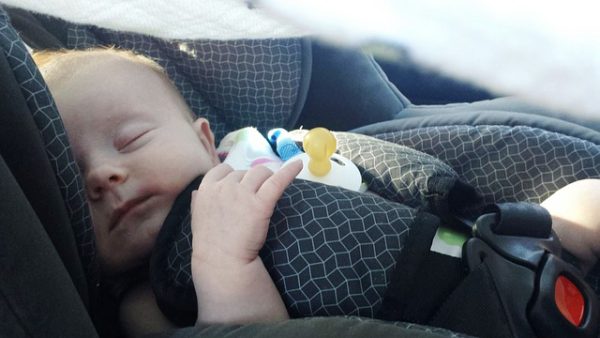This is a tricky item to pack. Checking a car seat is bulky and a pain to haul around, but essential in many cases.
Important: Make sure your car seat is approved for in-flight use by the FAA. It should have a sticker that says FAA-approved for aviation use or similar. You may be asked to show the counter staff this sticker during check in.
Note: you’ll be breaking the law if you have a child in a moving vehicle without a car seat in most U.S. cities. Taxi and ride share drivers will most likely refuse rides to your family if you don’t have a car seat for your child. This means that although you might get away with not using a car seat on a flight, you may have trouble getting a taxi or Uber home when you land.
Click here for video on installing a car seat on the plane.
Options for checking a car seat
You have 5 options when it comes to traveling and checking a car seat on an airplane.
Bring It Everywhere
Travel with the car seat, bring it on the plane, install it and haul it away with you when you disembark
Pro: your child is safely secured during the flight and has a somewhat familiar seat to sit and nap in. You’ll be able to use the same car seat for rides to and from the airport, and for the duration of your trip.
Con: lugging it through security and the terminal, installing it and uninstalling it and then lugging it through customs might be physically impossible or daunting for a single adult to handle. You’ll also need to purchase a seat for your child. With most flights overbooked nowadays, the chances of having a free open seat for your lap child are low.
Best for: Parents traveling with an adult helper who can help you schlep the car seat across the terminal, and/or watch your kid while you install and uninstall the car seat.
Gate-checking a Car Seat On Airplane
Bring the car seat right up to the plane door, then gate-check it. You’ll see your car seat again when you get off the plane
Pro: Some people believe that gate-checking an item means that it’ll receive gentler treatment from the baggage handlers.
A damaged car seat would impact its ability to protect your child in the event of a car accident. Car seats are also quite pricey, and you may not be compensated by the airline if your car seat does get damaged by the baggage handlers.
Con: your child won’t be securely harnessed during the flight and you’ll be compromising his/her safety, especially during unforeseen turbulence. You’ll also be going against the FAA (Federal Aviation Administration) and American Pediatric Association recommendation to secure a child in a car seat during a flight.
It is however, not illegal for a child to go car-seat less during a flight.
Best for: parents who don’t want to bring a car seat onto the plane and/or have expensive car seats that they want to protect from baggage handlers.
Checking a Car Seat on Airplane
Bring the car seat, but check the car seat on the airplane at the counter along with the rest of your checked in baggage
Pro: This is the easiest way for a single adult to travel with a child. You won’t be lugging a heavy car seat through security or across the airport, leaving your hands free to deal with your kid and TSA.
Con: Not securing your child during a flight is unsafe and can result in injuries if you were to encounter turbulence during a flight. Do not count of being able to “catch” your kid when things go south in the air – no parent’s arms are strong enough to hold down a child during sudden and serious turbulence.
Best for: parents traveling on their own who cannot physically lug around a car seat and a slew of baby gear.
Tip: A few of the airlines I’ve flown with have provided a large plastic bag to keep the car seat clean and dry. Consider bringing your own large plastic bag in case your airline doesn’t provide one. An extra-large laundry bag (the kind you use for hauling wash to the laundromat) may work in a pinch, although it won’t keep your car seat dry if it were left out on a rainy tarmac.
Skip It
Skip bringing the car seat completely. This option is problematic on many levels because you’ll need to find some way to get to the airport by car without using a car seat, which is illegal in the U.S.
Even if you were to, say leave the car seat in your car while it’s parked at the airport long term parking lot, you’ll need to buy or rent a car seat at your destination. Car rental companies generally rent out car seats at an additional cost, but the quality of these car seats vary widely and may not live up to your standards for hygiene or safety.
Pro: you don’t have to lug a car seat anywhere.
Con: See above for multiple cons. Additionally, your child will be unsecured during the flight, which can result in serious injuries during turbulence.
CARES
Check a car seat on an airplane at the counter along with the rest of your checked baggage, and use the CARES harness during the flight.
This is probably the easiest and safest method but unfortunately, it’ll only work on kids who are between 22-44 lbs. Meaning infants or newborns won’t be able to use the harness and you will be best off using a car seat during the flight.
Also, you will need to purchase a seat for your child to use the CARES harness, unless you can score a free, open seat next to you.
Pro: The CARES harness is certified by the FAA as an alternative to a car seat. It is easy to install and portable (weighs 1lb). It’s a tad pricey at $70, but still reasonable for portability and peace of mind.
Con: Won’t work for children who weigh less than 22lbs or lap infants without a paid seat.


Comments 1
You made various fine points there. I did a search on the issue and found the majority of people will have the same opinion with your blog.